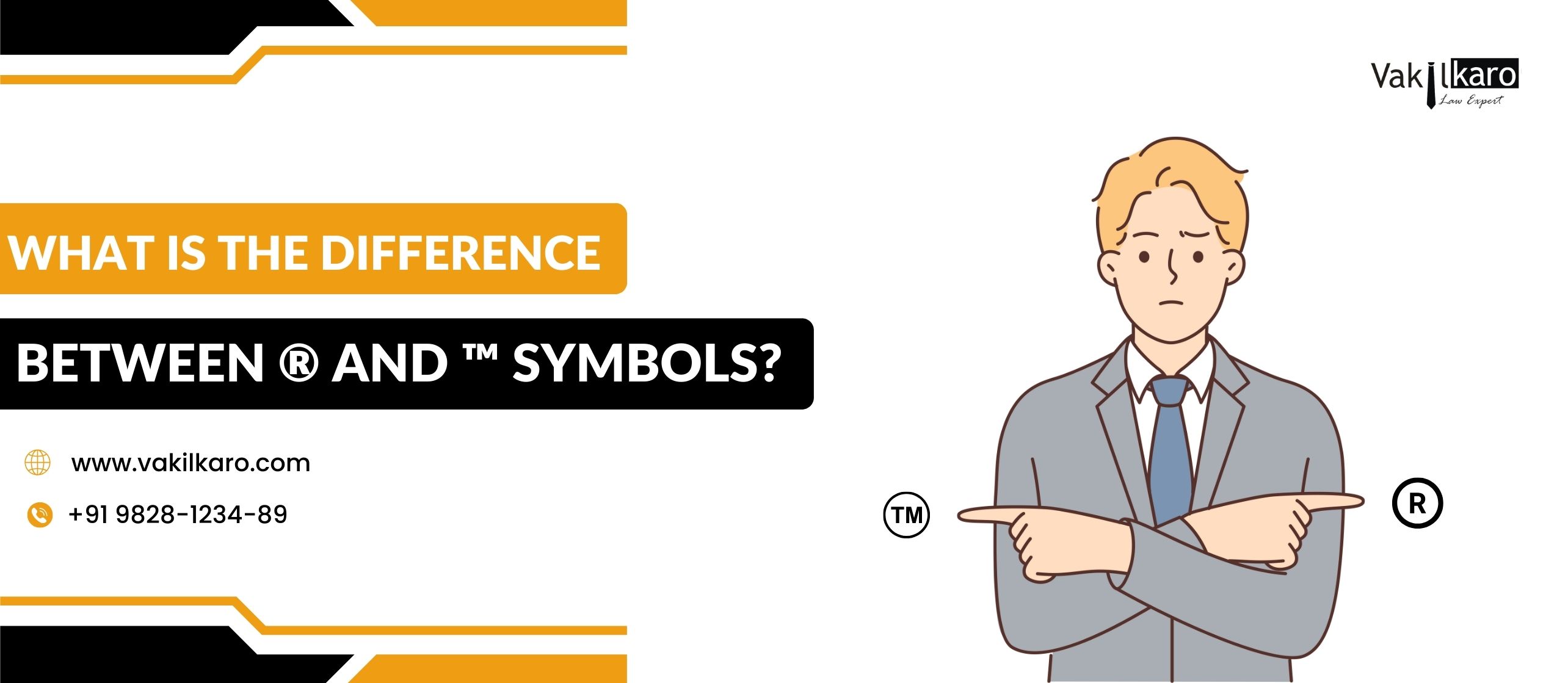Understanding the Difference Between ® and ™ Symbols
The ® and ™ symbols are essential in trademark protection, but they serve distinct legal purposes. The ™ symbol is used to indicate that a brand, slogan, logo, or phrase is being claimed as a trademark, even if it has not been officially registered. While it signals ownership, it does not grant exclusive legal rights or protection against trademark infringement
On the other hand, the ® symbol signifies that a trademark has been officially registered with a recognized trademark authority, granting the owner exclusive rights and stronger legal protection. Using the ™ symbol is common for businesses in the process of registering their trademarks or asserting ownership without formal trademark registration It acts as a public notice but does not provide legal grounds for enforcement in case of disputes.
In contrast, the ® symbol ensures nationwide or jurisdictional protection, allowing the owner to take legal action against unauthorized use or infringement. Proper use of these symbols is crucial for businesses aiming to establish and protect their brand identity. Incorrectly using the ® symbol without registration can lead to legal penalties, while failing to mark a trademark with ™ may weaken its claim in potential disputes.
Trademark symbols help businesses build consumer trust, enhance brand credibility, and prevent unauthorized use by competitors. Choosing the right symbol depends on whether a trademark has been registered, with ™ serving as a preliminary claim and ® reinforcing official legal status. By understanding the differences between these symbols, businesses can strengthen their intellectual property rights, prevent infringement, and maximize their brand’s value. Proper trademark management not only safeguards a company’s identity but also contributes to long-term market success by ensuring exclusivity and legal recognition.

Introduction
Trademarks play a crucial role in distinguishing brands and protecting intellectual property. While exploring trademarks, you may have noticed two common symbols: ™ (TM) and ® (R). Though they both indicate trademark usage, they serve different legal purposes. Understanding the distinction between the ® and ™ symbols is essential for businesses, entrepreneurs, and brand owners. This blog explores the meaning, legal implications, and usage of these symbols to help you navigate the world of trademarks effectively.
What is a Trademark?
A trademark is a unique sign, logo, word, phrase, or symbol that identifies a brand’s goods or services and differentiates them from competitors. Trademarks help build brand recognition and consumer trust while preventing unauthorized use by others. Businesses use trademarks to safeguard their brand identity and maintain exclusivity in the market.
Trademarks can be classified into different types, such as:
- Word Marks: Brand names or slogans (e.g., Nike, Just Do It).
- Design Marks: Logos or unique graphical elements (e.g., Apple logo).
- Combination Marks: A mix of words and designs.
- Service Marks: Trademarks specifically for services rather than physical goods.
To strengthen brand protection, businesses use trademark symbols like ™ and ®, but they serve distinct legal purposes.
Understanding the ™ (TM) Symbol
The ™ (TM) symbol is used to indicate that a business is claiming a particular word, phrase, logo, or symbol as a trademark, even if it has not been registered with a government trademark office. The TM symbol serves as a public notice of ownership but does not provide legal protection or exclusive rights.
Key Features of the TM Symbol:
- Indicates Unregistered Trademarks: Used for trademarks that are not yet registered with official authorities.
- Provides Limited Protection: While it signals ownership, it does not offer legal exclusivity.
- Can Be Used Freely: Businesses can use TM without formal approval from a trademark office.
- Applies to Goods and Services: Can be used for both physical products and services.
- Recognized in Many Jurisdictions: While not legally binding, it is widely acknowledged in business practices.
When to Use the TM Symbol
- If you have a brand name, logo, or slogan that you want to claim as a trademark.
- When your trademark application is still pending approval.
- If you want to publicly assert ownership of your mark before official registration.

Understanding the ® (R) Symbol
The ® (R) symbol signifies a registered trademark, meaning the mark has been officially recognized and granted legal protection by a trademark office, such as the United States Patent and Trademark Office(USPTO), the European Union Intellectual Property Office(EUIPO), or the Controller General of Patents, Designs, and Trademarks in India.
Key Features of the R Symbol:
- Indicates Official Registration: This can only be used once a trademark is legally registered.
- Provides Legal Protection: Grants exclusive rights to use the mark for specific goods or services.
- Deters Unauthorized Use: Helps prevent infringement and unauthorized use by competitors.
- Subject to Renewal: Registration must be renewed periodically (e.g., every 10 years in many jurisdictions).
- Restricted Usage: Using the ® symbol without registration can result in legal penalties.
When to Use the R Symbol
- Once your trademark has been officially registered with a trademark office.
- To assert legal ownership and exclusive rights over your brand elements.
- When you want to strengthen your legal standing in case of disputes or infringement.
Legal Implications of Using TM and R Symbols
The legal protections associated with these symbols vary significantly:
TM Symbol:
- Does not grant exclusive rights or legal enforceability.
- Serves as a warning to others about your claim.
- Can be used freely without government approval.
- Does not guarantee protection in trademark disputes.
R Symbol:
- Grants legal exclusivity and nationwide protection in registered jurisdictions.
- Allows the owner to take legal action against infringement.
- Can be enforced in court with stronger legal standing.
- Misuse (using R without registration) can lead to legal consequences.
How to Register a Trademark and Obtain the R Symbol
To use the ® symbol legally, you must register your trademark with the appropriate government body. Here’s an overview of the process:
Step 1: Conduct a Trademark Search
Before filing, conduct a comprehensive trademark search to ensure your mark is unique and not already in use. This step helps avoid rejection and legal conflicts.
Step 2: File a Trademark Application
Submit a trademark application to the relevant authority, such as:
- USPTO (United States)
- EUIPO (European Union)
- IP Australia (Australia)
- CIPO (Canada)
- CGPDTM (India)
Include details such as:
- The trademark name/logo
- Goods or services it represents
- Owner details
- Proof of use (if required)
Step 3: Examination and Review
Trademark offices review applications to ensure they meet legal requirements and do not conflict with existing trademarks. This process may take several months.
Step 4: Publication for Opposition
Once approved, the trademark is published in an official journal for a period (e.g., 30-90 days), allowing third parties to object if they believe the mark infringes on their rights.
Step 5: Trademark Registration and Issuance of Certificate
If no opposition arises, or any objections are resolved, the trademark office grants registration, and the applicant can legally use the ® symbol.
Misuse of TM and R Symbols
Incorrect usage of trademark symbols can lead to legal and reputational risks.
Common Mistakes:
- Using the R Symbol Without Registration: This can result in fines and legal action.
- Not Using Any Symbol: Failing to mark trademarks weakens brand protection.
- Using TM for a Registered Trademark: Though not illegal, it fails to convey the full legal protection of registration.
Benefits of Using the Correct Trademark Symbol
Proper usage of TM and R symbols offers multiple benefits:
- Brand Recognition: Helps consumers identify and trust your brand.
- Legal Protection: Strengthens claims against infringement.
- Competitive Advantage: Distinguishes your brand from competitors.
- Market Value Enhancement: Increases business credibility and asset value.
Relevance of Trademark Registration in Understanding the Difference Between ® and ™ Symbols
Trademark registration plays a crucial role in distinguishing between the ® and ™ symbols. The ™ symbol signifies a brand’s claim over a mark, even without official registration, offering limited protection. In contrast, the ® symbol indicates a legally registered trademark, granting exclusive rights and stronger legal enforcement against infringement. Without registration, a trademark lacks full legal security, making it vulnerable to disputes. Registering a trademark ensures brand recognition, market exclusivity, and legal protection. Understanding this distinction helps businesses safeguard their intellectual property, prevent misuse, and enhance their brand’s credibility and long-term value in competitive markets.
Conclusion
Understanding the difference between ™ and ® symbols is vital for businesses seeking to protect their brand. The TM symbol is useful for unregistered marks, signaling ownership claims, while the R symbol provides legal exclusivity for registered trademarks. Proper trademark usage enhances brand identity, ensures legal protection, and helps prevent infringement. Whether you are developing a new brand or managing an existing one, using the appropriate trademark symbols correctly can safeguard your intellectual property and strengthen your market position.
Why Choose Vakilkaro for Trademark Registration and Related Services?
Vakilkaro is a trusted legal service provider specializing in trademark registration and intellectual property protection. Their expert team simplifies the trademark registration process, ensuring businesses can legally secure exclusive rights to their brand and properly use the ® and ™ symbols. Vakilkaro conducts comprehensive trademark searches, files applications, handles objections, and provides legal guidance to prevent infringement issues. Beyond registration, they offer services like trademark renewal, opposition handling, licensing, and selling trademarks. With a client-centric approach, Vakilkaro ensures seamless legal compliance, brand protection, and hassle-free trademark management, making them the ideal choice for safeguarding intellectual property rights. Accordingly, Vakilkaro provides other services like GST Registration Section 8 Microfinance Company Registration and, including but not limited to, FASSAI Registration.